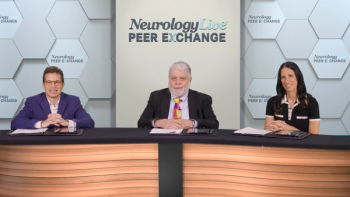
Trial Data Models Patient Transport for Suspected Stroke with Large-Vessel Occlusion
For ischemic stroke with suspected large-vessel occlusion, regional centralization of care is estimated to result in the best outcomes.
Tudor Jovin, MD
A new theoretical, conditional probability modeling study concluded that for patients with suspected acute ischemic stroke with large-vessel occlusion, regional centralization of stroke triage to endovascular therapy centers will increase positive outcomes and immediate alteplase treatment followed by transfer to the endovascular center is best for longer transport times.
Researchers examined whether thrombolysis-capable stroke centers be bypassed in favor of direct transfer to endovascular-capable stroke centers. The dominant transport strategy is dependent on the patient’s distance to both centers and treatment speed. If the treatment times are slow at the thrombolysis center, bypass should be considered when centers are 60 minutes or less apart, however, with greater transport times between centers, bypass is not always ideal.
“A big component and a big direction of development in acute stroke therapies has to happen with systems of care, and it starts with the pre-hospital evaluation—from when the call to 911 is made, the first medical contact, to the delivery to the hospital,” Tudor Jovin, MD, assistant professor of neurology and neurosurgery at the University of Pittsburgh School of Medicine, co-director of the Center for Endovascular Therapy at the University of Pittsburgh Medical Center told NeurologyLive. “The big debate now in the field is: where should these patients be delivered? A key component to this is being able to identify in the field—before the patient comes to the hospital—that they do indeed have a large vessel occlusion. If you identify that, then, the debate becomes: should you take them directly to a thrombectomy center, or should you take them to the closest primary center, where they can give intravenous tissue plasminogen activator (tPA) and transfer them from there.”
A prehospital transport system was modeled and visualized for patients with acute ischemic stroke with suspected large-vessel occlusion utilizing clinical trial data, balancing the benefit of early alteplase treatment, the greater efficacy of endovascular therapy and declining benefit of both treatments over time. The study was conducted Feb. 1, 2017—March 1, 2018.
The study analyzed 2 different treatment paradigms: the mothership paradigm, patients are transported directly to an endovascular therapy center, potentially bypassing closer thrombolysis centers, and the drip-and-ship paradigm, patients are first treated with intravenous alteplase at a thrombolysis center then transferred to an endovascular therapy center. Three different time scenarios were used: scenario A describes an optimized system, scenario B assumes slow treatment at the thrombolysis center, and scenario C assumes slow treatment at both centers. The several scenarios were created to illustrate the association of varying transport times, treatment times and screening-tool positive predictive values with decision making and were visualized using 2-D temporospatial diagrams and in California.
“[A] critical aspect of acute stroke treatment has to do with systems of care. There are still a lot of patients who, despite hugely beneficial treatment effects and despite the fact that pretty much all categories of patients that are being evaluated within the early time window, benefit from thrombectomy,” Tudor added. “We still take way too long, and we still don’t get enough patients to the hospital. And when we get them to the hospital, we take way too long to get them to a thrombectomy center. Even within the thrombectomy center, we take too long for them to get to the procedure suite.”
Patients closest to the endovascular therapy center were estimated to have the greatest probability of an excellent outcome. Those with known contraindications to thrombolysis, which included those beyond 4.5 hours from onset, should be transported directly to an endovascular therapy center. Outcomes vary by transport time and treatment efficiency for patients closest to the thrombolysis center.
In scenario A with optimal treatment times (door-to-needle time: 30 minutes; door-in-door-out time: 50 minutes; door-to-groin-puncture time: 60 minutes [mothership], 30 minutes [drip and ship]), when the thrombolysis and endovascular therapy centers are less than 60 minutes of travel time apart, both strategies estimate near-equivalent probabilities of excellent outcome.
In scenario B, (door-to-needle time: 60 minutes [thrombolysis center], 30 minutes [EVT center]; door-in-door-out time: 120 minutes; door-to-groin-puncture time 60 minutes [mothership], 30 minutes [drip-and-ship]) slowing treatment at a thrombolysis center is shown and drip-and-ship is no longer associated with a greater possibility of greater outcome when travel time between centers is 60 minutes or less. As travel time increases, drip-and-ship only outweighs mothership when travel time precludes patients from receiving alteplase in the mothership model.
In scenario C (door-to-needle time: 60 minutes; door-in-door-out time: 120 minutes; door-to-groin-puncture time: 90 minutes [mothership], 60 minutes [drip-and-ship]) the drip-and-ship outweighs mothership only when travel time precludes alteplase administration in the mothership scenario or if the centers are 120 minutes apart and the patient is in close proximity of the thrombolysis center.
In an optimal scenario consistent with 2D temporospatial diagrams, drip-and-ship outweighs mothership only when the thrombolysis center is far from the endovascular therapy centers. The study found that transport time threshold for bypass varies depending on treatment speed at thrombolysis and endovascular therapy centers. The threshold is noticeable in scenario B, where door-to-needle time at thrombolysis centers is 60 minutes (door-in-door-out time, 120 minutes). Among hospitals in the Get With the Guidelines Target Stroke program, the postintervention median door-to-needle time was 67 minutes (interquartile range 51—87 minutes). Based on current treatment times, the results imply that delivery should be regionally centralized based on the full benefit of endovascular therapy on a population basis.
“One thing that has become undisputed in this field is that this procedure is exquisitely time sensitive. Especially when you take non-selective patients that you treat within 6 hours. There’s a very strong time sensitivity that goes along with treatment benefit, with earlier treated patients deriving much more significant benefit,” concluded Jovin. “The treatment paradigms that identify large vessel occlusion patients and send them as quickly as possible to a thrombectomy center are now sort of the Holy Grail of acute stroke with large vessel occlusion treatments.”
Researchers note that because transport decision making is context specific and the radius changes based on relative location of centers to each other and treatment times at the centers, model inputs need to be customized regionally, which has potential implications for current accreditation standards and time metrics for quality stroke care. Areas where both transport options produce near-equivalent outcomes may be treated differently based on jurisdiction, economics, staffing and/or redundancy in resources. Changes in technology, treatment paradigms or the use of mobile stroke units may affect stroke care, and as further data become available, the models can be updated. For jurisdictional planning, health systems should evaluate several scenarios including nonoptimal driving conditions before deciding on a transport strategy. The decision making for prehospital transport can be modeled utilizing existing clinical trial data, which can then be adapted to changing realities.
REFERENCE
Holodinsky J, Williamson T, Demchuk A, et al. Modeling Stroke Patient Transport for All Patients With Suspected Large-Vessel Occlusion. JAMA Neurology. 2018.
doi
:10.1001/jamaneurol.2018.2424.
Newsletter
Keep your finger on the pulse of neurology—subscribe to NeurologyLive for expert interviews, new data, and breakthrough treatment updates.





































